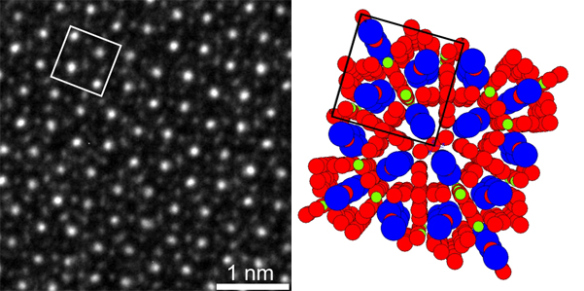Neo-mag: The strongest permanent magnet of them all!
What does it look like?

Left: High-resolution transmission electron microscopy image of Nd2Fe14B; right: crystal structure with unit cell marked. Nd in blue, Fe in red and B in yellow (source: http://en.wikipedia.org/wiki/Neodymium_magnet).
What is it?
Many of today's technological devices that we often take for granted (cars, mobile phones, laptops, memory devices) rely heavily on the magnetic properties of materials. One such property of a magnet that scientists are trying to enhance is its "hardness" – or strength as a permanent magnet. This can be seen in the rare-earth magnetic material Nd2Fe2B, which is considered to be the strongest permanent magnet around and is ferromagnetic (with all magnetic moments aligned in the same direction) for all temperatures up to 400°C. It has an exceptionally high anisotropy, indicating that the magnetic moments have a strong preference to align along one crystallographic direction. When we apply a magnetic field in the opposite direction to the moments, Nd2Fe2B also shows a strong resistance to flip the spins indicating a high coercivity (750–2000 kA/m). It is these properties that make Nd2Fe2B such a useful magnetic material. Another hard magnet with similar properties to Nd2Fe2B is SmCo5.
Where did the structure come from?
Since the development of this material by General Motors and Sumitomo Special Metals in 1982 Nd2Fe2B has found its way into a myriad of modern devices such as computer hard disks, magnetic resonance imaging (MRI) scanners, door locks, electric motors (in particular for cordless devices), hybrid and electric cars, and electric generators. There are, however, caveats to consider when using this material – it is highly corrosive, necessitating Ni plating of all parts, and the rare-earth component makes them relatively expensive to produce.






